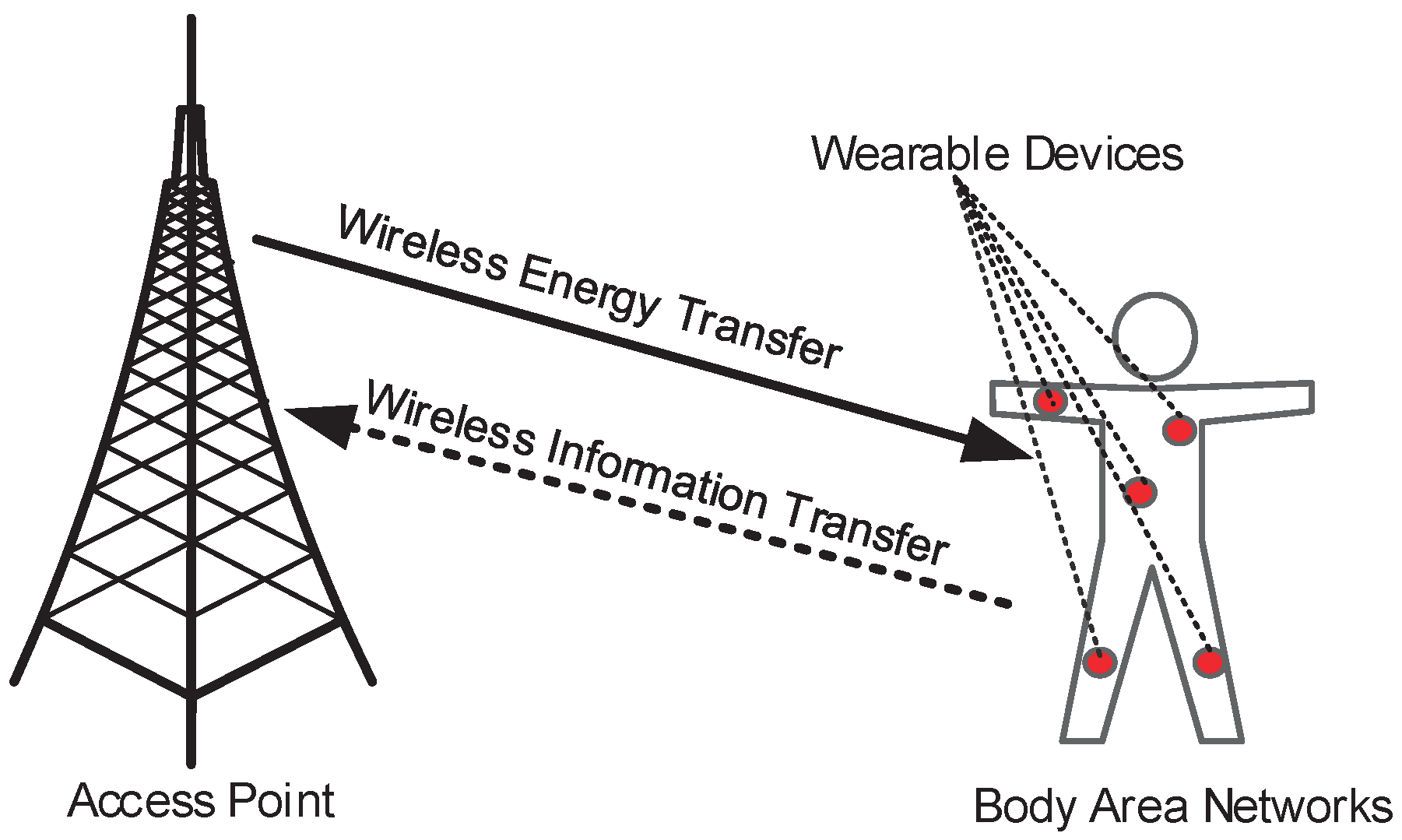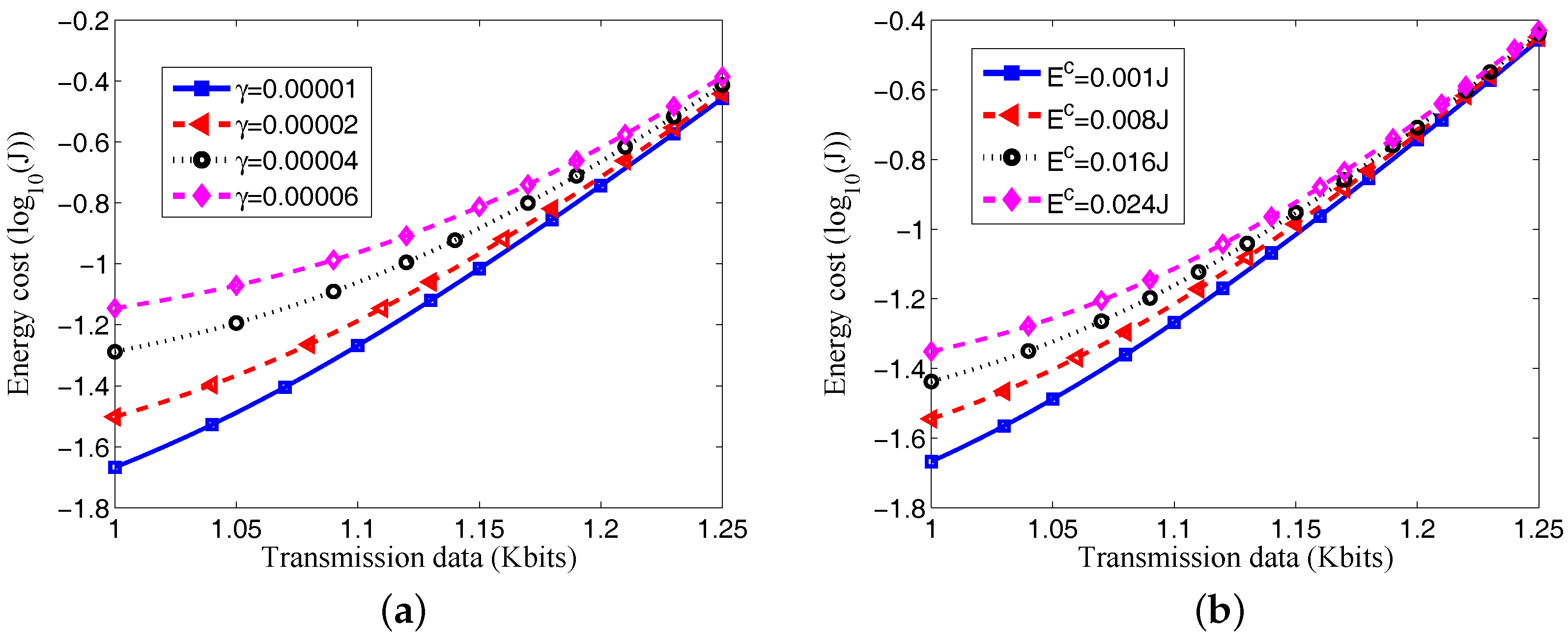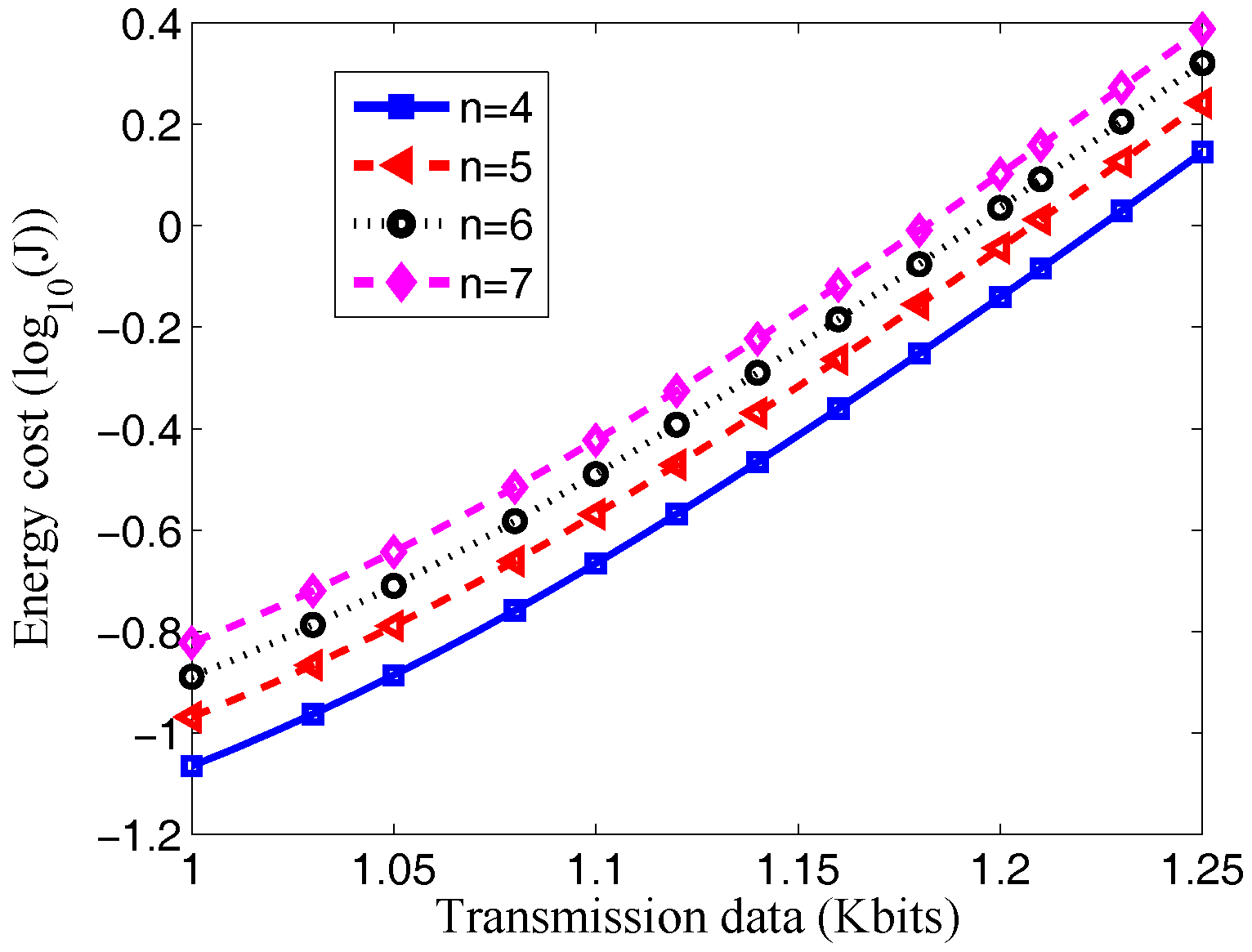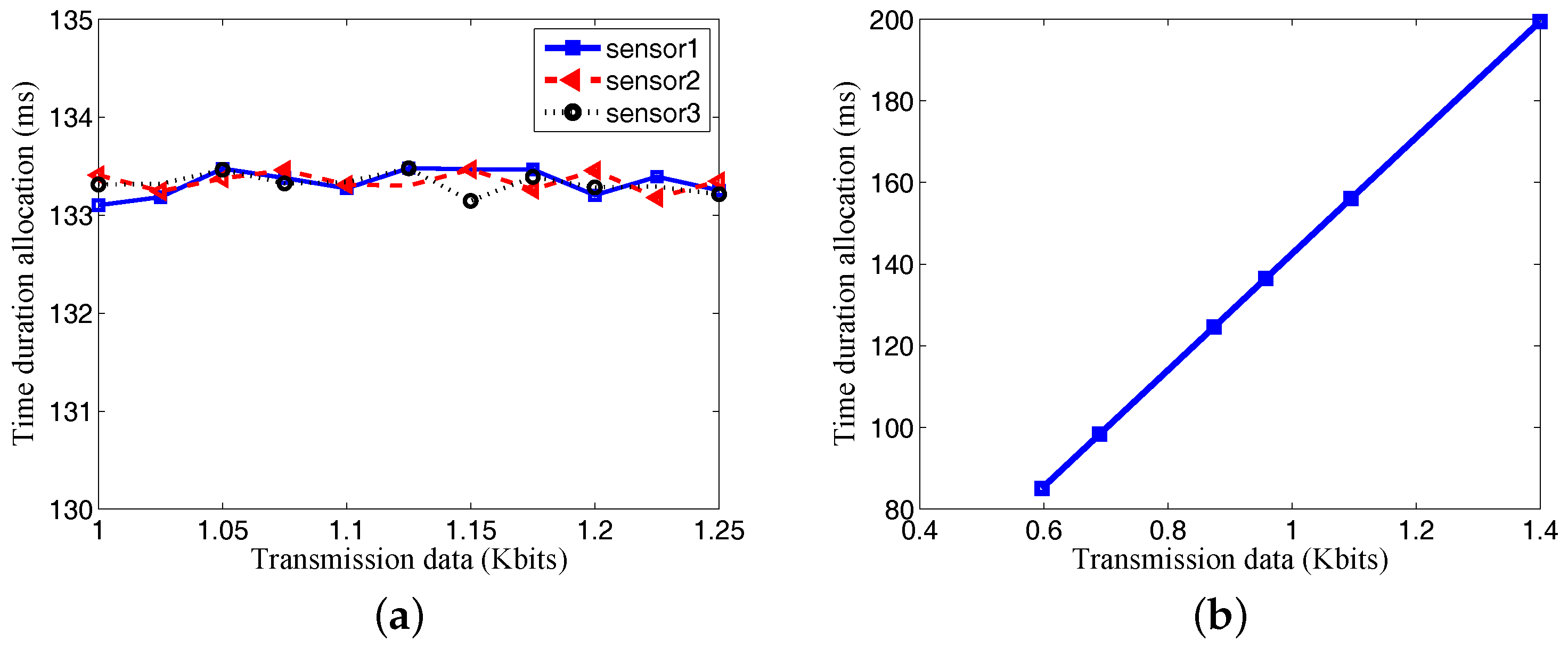Energy Harvesting Based Body Area Networks for Smart Health
Abstract
:1. Introduction
- Energy harvesting through the environment: some sensors harvest energy through renewable energy sources (including solar, wind, and luminous energy resources).
- Energy harvesting through the human body: some sensors harvest energy from their own heat energy, bio-energy, body surface friction and body movement.
- Energy harvesting through a wireless signal: some sensors harvest energy by acquiring wireless signals.
- We introduce energy harvesting into a BAN to improve BAN energy efficiency. Compared with traditional BANs, the energy harvesting based BAN proposed in this paper can significantly improve the BAN energy efficiency.
- We formulate the optimization problem concerning time allocation for the WET and WIT in a BAN, with the aim of minimizing energy consumption in the sensor when considering the WIT and WET time limits. Furthermore, we convert such a problem into a convex optimization problem under linear constraints.
- We propose a closed-form solution to the optimization problem based on Karush–Kuhn–Tucker (KKT) conditions. Simulation results showed that when the size of data acquired by the wearable devices is small, the proportion of energy consumed by the circuit and information collection of the wearable devices is big, and when the size of data acquired by the wearable devices is big, the energy consumed by information transfer of the wearable device is decisive.
2. System Model
2.1. Energy Harvesting-Based Body Area Networks Model
2.2. Transmission Model
2.3. Energy Consumption Model
- Energy consumed by the circuit of the sensor . Considering that the sensor works constantly, this energy is constant and we denote it as .
- Energy consumed by signals (such as the perception, collection and storage of signals) processed by the sensor . This part of energy consumption is associated with the data size which is denoted as to be processed. Let denote the energy consumed by the processing of one bit of data. Then, this part of energy can be expressed as .
- Energy consumed for information transfer by the sensor . This part of energy consumption is also related to the data size and can be represented as .
3. Problem Formulation and Solution
3.1. Problem Formulation
3.2. Closed-Form Solution
4. Simulation Results
4.1. Parameter Setting
4.2. Energy Cost of Sensors
4.3. Time Duration Allocation of Sensors
5. Conclusions
Acknowledgments
Author Contributions
Conflicts of Interest
References
- Habib, C.; Makhoul, A.; Darazi, R.; Salim, C. Self-adaptive data collection and fusion for health monitoring based on body sensor networks. IEEE Trans. Ind. Inform. 2016, 12, 2342–2352. [Google Scholar] [CrossRef]
- Chen, M.; Gonzalez, S.; Vasilakos, A.; Cao, H.; Leung, V.C. Body area networks: A survey. Mob. Netw. Appl. 2011, 16, 171–193. [Google Scholar] [CrossRef]
- Negra, R.; Jemili, I.; Belghith, A. Wireless Body Area Networks: Applications and Technologies. Procedia Comput. Sci. 2016, 83, 1274–1281. [Google Scholar] [CrossRef]
- Chen, M.; Ma, Y.; Li, Y.; Wu, D.; Zhang, Y.; Youn, C.H. Wearable 2.0: Enabling Human-Cloud Integration in Next Generation Healthcare Systems. IEEE Commun. Mag. 2017, 55, 54–61. [Google Scholar] [CrossRef]
- Abid, A.; O’Brien, J.M.; Bensel, T.; Cleveland, C.; Booth, L.; Smith, B.R.; Langer, R.; Traverso, G. Wireless Power Transfer to Millimeter-Sized Gastrointestinal Electronics Validated in a Swine Model. Sci. Rep. 2017, 7, 46745. [Google Scholar] [CrossRef] [PubMed]
- Chen, M.; Hao, Y.; Hwang, K.; Wang, L.; Wang, L. Disease Prediction by Machine Learning over Big Data from Healthcare Communities. IEEE Access 2017, 5, 8869–8879. [Google Scholar] [CrossRef]
- Chen, M.; Zhou, P.; Fortino, G. Emotion Communication System. IEEE Access 2017, 5, 326–337. [Google Scholar] [CrossRef]
- Lin, K.; Song, J.; Luo, J.; Ji, W.; Hossain, M.S.; Ghoneim, A. GVT: Green video transmission in the mobile cloud networks. IEEE Trans. Circuits Syst. Video Technol. 2017, 27, 159–169. [Google Scholar] [CrossRef]
- Lin, K.; Luo, J.; Hu, L.; Hossain, M.S.; Ghoneim, A. Localization based on Social Big Data Analysis in the Vehicular Networks. IEEE Trans. Ind. Inform. 2016. [Google Scholar] [CrossRef]
- Chen, M.; Yang, J.; Hao, Y.; Mao, S.; Hwang, K. A 5G cognitive system for healthcare. Big Data Cogn. Comput. 2017, 1, 2. [Google Scholar] [CrossRef]
- Zhou, Y.; Sheng, Z.; Mahapatra, C.; Leung, V.C.; Servati, P. Topology design and cross-layer optimization for wireless body sensor networks. Ad Hoc Netw. 2017, 59, 48–62. [Google Scholar] [CrossRef]
- Tsouri, G.R.; Prieto, A.; Argade, N. On increasing network lifetime in body area networks using global routing with energy consumption balancing. Sensors 2012, 12, 13088–13108. [Google Scholar] [CrossRef] [PubMed]
- Gravina, R.; Alinia, P.; Ghasemzadeh, H.; Fortino, G. Multi-sensor fusion in body sensor networks: State-of-the-art and research challenges. Inf. Fusion 2017, 35, 68–80. [Google Scholar] [CrossRef]
- Zhang, H.; Liu, J.; Pang, A.C.; Li, R. A Data Reconstruction Model Addressing Loss and Faults in Medical Body Sensor Networks. In Proceedings of the IEEE Global Communications Conference (GLOBECOM), Washington, DC, USA, 4–8 December 2016. [Google Scholar]
- Chen, X.; Xu, Y.; Liu, A. Cross Layer Design for Optimizing Transmission Reliability, Energy Efficiency, and Lifetime in Body Sensor Networks. Sensors 2017, 17, 900. [Google Scholar] [CrossRef] [PubMed]
- Qiu, M.; Ming, Z.; Li, J.; Liu, J.; Quan, G.; Zhu, Y. Informer homed routing fault tolerance mechanism for wireless sensor networks. J. Syst. Archit. 2013, 59, 260–270. [Google Scholar] [CrossRef]
- Qiu, M.; Sha, E.H.M. Cost minimization while satisfying hard/soft timing constraints for heterogeneous embedded systems. ACM Trans. Des. Autom. Electron. Syst. 2009, 14, 25. [Google Scholar] [CrossRef]
- Qiu, M.; Ming, Z.; Li, J.; Liu, S.; Wang, B.; Lu, Z. Three-phase time-aware energy minimization with DVFS and unrolling for chip multiprocessors. J. Syst. Archit. 2012, 58, 439–445. [Google Scholar] [CrossRef]
- Zhou, L.; Wu, D.; Zheng, B.; Guizani, M. Joint physical-application layer security for wireless multimedia delivery. IEEE Commun. Mag. 2014, 52, 66–72. [Google Scholar] [CrossRef]
- D’Andreagiovanni, F.; Nardin, A. Towards the fast and robust optimal design of Wireless Body Area Networks. Appl. Soft Comput. 2015, 37, 971–982. [Google Scholar] [CrossRef]
- D’Andreagiovanni, F.; Nardin, A.; Natalizio, E. A fast ILP-based Heuristic for the robust design of Body Wireless Sensor Networks. In Applications of Evolutionary Computation; Springer: Vienna, Austria, 2017; Volume 10199, pp. 234–250. [Google Scholar]
- D’Andreagiovanni, F.; Krolikowski, J.; Pulaj, J. A fast hybrid primal heuristic for multiband robust capacitated network design with multiple time periods. Appl. Soft Comput. 2015, 26, 497–507. [Google Scholar] [CrossRef]
- D’Andreagiovanni, F.; Nace, D.; Nardin, A.; Natalizio, E. Robust relay node placement in body area networks by heuristic min-max regret. In Proceedings of the IEEE Balkan Conference on Communications and Networking (BALKANCOM), Tirana, Albania, 30 May–2 June 2017. [Google Scholar]
- Lin, K.; Chen, M.; Deng, J.; Hassan, M.M.; Fortino, G. Enhanced fingerprinting and trajectory prediction for IoT localization in smart buildings. IEEE Trans. Autom. Sci. Eng. 2016, 13, 1294–1307. [Google Scholar] [CrossRef]
- Zhou, L. QoE-driven delay announcement for cloud mobile media. IEEE Trans. Circuits Syst. Video Technol. 2017, 27, 84–94. [Google Scholar] [CrossRef]
- Chen, M.; Ma, Y.; Song, J.; Lai, C.F.; Hu, B. Smart clothing: Connecting human with clouds and big data for sustainable health monitoring. Mob. Netw. Appl. 2016, 21, 825–845. [Google Scholar] [CrossRef]
- Ghazanfari, A.; Tabassum, H.; Hossain, E. Ambient RF energy harvesting in ultra-dense small cell networks: Performance and trade-offs. IEEE Wirel. Commun. 2016, 23, 38–45. [Google Scholar] [CrossRef]
- Hao, Y.; Chen, M.; Hu, L.; Song, J.; Volk, M.; Humar, I. Wireless Fractal Ultra-Dense Cellular Networks. Sensors 2017, 17, 841. [Google Scholar] [CrossRef] [PubMed]
- Xiong, K.; Fan, P.; Zhang, C.; Letaief, K.B. Wireless information and energy transfer for two-hop non-regenerative MIMO-OFDM relay networks. IEEE J. Sel. Areas Commun. 2015, 33, 1595–1611. [Google Scholar] [CrossRef]
- Bi, S.; Zhang, R. Placement optimization of energy and information access points in wireless powered communication networks. IEEE Trans. Wirel. Commun. 2016, 15, 2351–2364. [Google Scholar] [CrossRef]
- You, C.; Huang, K.; Chae, H. Energy efficient mobile cloud computing powered by wireless energy transfer. IEEE J. Sel. Areas Commun. 2016, 34, 1757–1771. [Google Scholar] [CrossRef]
- Boyd, S.; Vandenberghe, L. Convex Optimization; Cambridge University Press: Cambrige, UK, 2004. [Google Scholar]





© 2017 by the authors. Licensee MDPI, Basel, Switzerland. This article is an open access article distributed under the terms and conditions of the Creative Commons Attribution (CC BY) license (http://creativecommons.org/licenses/by/4.0/).
Share and Cite
Hao, Y.; Peng, L.; Lu, H.; Hassan, M.M.; Alamri, A. Energy Harvesting Based Body Area Networks for Smart Health. Sensors 2017, 17, 1602. https://doi.org/10.3390/s17071602
Hao Y, Peng L, Lu H, Hassan MM, Alamri A. Energy Harvesting Based Body Area Networks for Smart Health. Sensors. 2017; 17(7):1602. https://doi.org/10.3390/s17071602
Chicago/Turabian StyleHao, Yixue, Limei Peng, Huimin Lu, Mohammad Mehedi Hassan, and Atif Alamri. 2017. "Energy Harvesting Based Body Area Networks for Smart Health" Sensors 17, no. 7: 1602. https://doi.org/10.3390/s17071602




